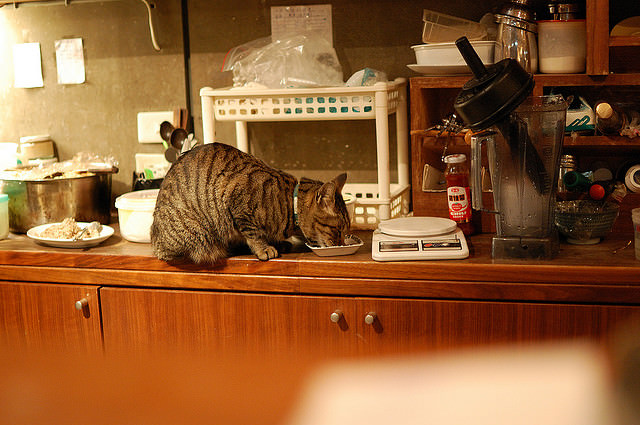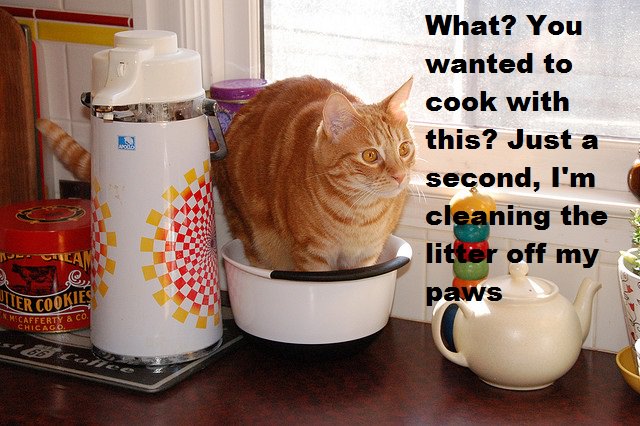According to Gallup’s annual Lifestyle Poll, almost 20% of Americans own both a cat and a dog. And, according to the APPA, 31% have two cats and 24 percent have three or more, with the average being 2 cats per household.

All these numbers point to one thing – food sharing. If you have dogs, you may have tried just about everything to keep them out of the cat food. Or maybe you have an older cat with a special diet that cannot have what the younger cat is eating.
One solution many pet owners use – feeding the cat on the counter. The dogs can’t reach it; the older kitty can’t jump that high any more. Problem solved.
But now you have another problem – cleanliness.
Zoonotic Diseases

Zoonotic diseases are all over your fine feline’s paws, his food dish and the food itself may not even be that clean (depending on what you are feeding.
Cornell University’s College of Veterinary Medicine has an entire page dedicated to Zoonotic diseases you can “catch” from your cat.
The most common diseases are bacterial (like salmonella!), parasites (fleas, worms), fungal infections (ringworm), protozoal infections (giardia), and rabies.
And how are these transmitted? The top ways listed by Cornell University are:
- Direct contact with secretions or excretions (saliva or feces)
- Contact with food or water that has been contaminated
- Fleas or ticks
Aside from the last one, all of these are things are made possible by having your cat eat on your counter. His salvia, hair, food and water are all right next to you where you prepare your food – yuck! Not to mention those paws that were just in his kitty toilet…

But you have to keep the food separate…so what should you do?
Tips To Feeding Your Cat OFF The Counter
There are several approaches to feeding time that can make sure everyone is only eating their own food, none of which involve putting kitty on the counter.
Do not free feed your cats. This eliminates the need for having food accessible to one animal all the time, and not to others. Plus, most vets and cat behaviorists agree this is not a good method for a couple reasons: it can lead to obesity, and it’s hard to tell if your cat is not eating much or anything at all, which can be a sign of illness.
Feed everyone at the same time, every day. Animals like routine. This will help them not want to each other foods if they have their own at the same time.
Activity feeders for the dogs. If your dog wolfs his food so he can gulp the cat’s down before she’s done, start feeding him in a puzzle toy that will take him longer to figure out. This gives kitty time to eat.
Separate rooms or kennels. Feeding all your animals in separate rooms or kennels is an easy way to ensure no one gets someone else’s food.
Feed-Safe Feeding Station. If, for some reason, you cannot put your dog in a contained area while your cat is eating, you may want to invest in this feeder. It allows your cat to get in, but not your dog. It wouldn’t work if you have small dogs, of course, but larger dogs it should work. A caveat – if your dog is a chewer, he is going to see this as a great big puzzle toy and should you leave him home alone with it, he is going to find a way to get into that food, so I see it as a great tool for when you are home to keep an eye on things.


